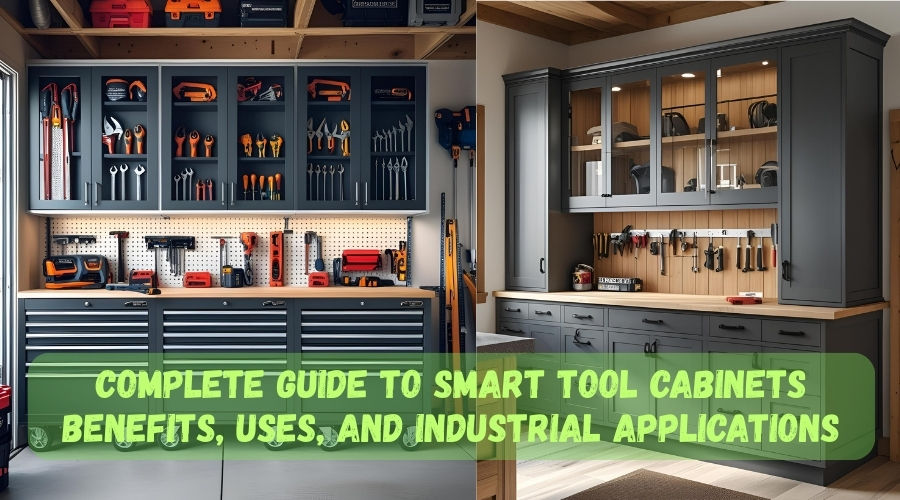Complete Guide to Smart Tool Cabinets: Benefits, Uses, and Industrial Applications
- toolcabinetsol
- Aug 21
- 5 min read

Introduction
Smart Tool Cabinets are changing how workshops, factories, and industrial sites manage tools. Unlike traditional cabinets, these intelligent systems combine secure storage with real-time tracking, automation, and analytics. As industries face rising costs from misplaced tools and downtime, adopting smart solutions is no longer optional. It’s a competitive advantage for businesses that value efficiency and accountability.
What Is a Tool Cabinet? A Quick Overview
A tool cabinet is a storage unit designed to organize, protect, and provide quick access to tools. Traditional cabinets offer drawers, locks, and compartments. However, modern industries need more than storage they need connected systems that track tool usage, reduce errors, and prevent losses. This is where the evolution toward smart solutions began.
The Shift from Traditional to Smart Storage
Standard tool cabinets improve organization, but they fail to address accountability, traceability, and misuse. Smart systems add RFID, barcode scanning, and IoT connectivity. These upgrades allow managers to see who accessed a tool, when it was removed, and whether it was returned. This eliminates guesswork and introduces a culture of responsibility in the workplace.
How Smart Tool Cabinets Work
Smart cabinets use sensors, RFID tags, and cloud connectivity to manage tools automatically. Each tool is tagged and linked to a database. When workers access the cabinet, the system records the transaction. Managers can then monitor usage patterns, schedule maintenance, and prevent unauthorized access. This creates a seamless integration between physical storage and digital management.
Benefits of Smart Tool Cabinets for Businesses
One major benefit is enhanced accountability. Every tool has a digital record, making theft or misplacement nearly impossible. Another benefit is reduced downtime, as workers spend less time searching for equipment. According to the National Association of Manufacturers, U.S. manufacturers lose an estimated $50 billion annually to downtime much of it preventable through better tool management.
Security and Access Control
Smart cabinets ensure that only authorized staff can access tools. Biometric systems, PIN codes, or ID cards can regulate entry. If a tool is missing, the system identifies the responsible user. This minimizes theft and ensures tools are used properly. For industries where safety is critical, such as aviation and defense, this accountability is non-negotiable.
Time Savings and Operational Efficiency
Employees often waste valuable time searching for misplaced tools. A smart cabinet eliminates this inefficiency. With automated check-in and check-out, every tool’s location is tracked. Research from Deloitte shows that companies with automated storage systems improve productivity by 20–30%. Smart cabinets directly contribute to leaner operations and reduced labor costs.
Cost Reduction and ROI Advantages
Smart cabinets reduce unnecessary purchases by preventing duplicate orders. They also extend tool lifespan through proper handling and maintenance reminders. In industries where tools can cost thousands of dollars each, avoiding losses translates into substantial savings. The ROI often appears within the first year of implementation, making these systems a practical investment.
Tool Tracking and Real-Time Monitoring
One of the most powerful features is real-time tracking. Managers can log into a dashboard and see which tools are in use, who is using them, and how often. This data prevents overstocking or underutilization. Over time, businesses can optimize inventory, forecast demand, and improve procurement strategies based on actual usage patterns.
Integration with ERP and Inventory Systems
Smart Tool Cabinets are not isolated units. They can integrate with enterprise resource planning (ERP) software, creating a unified flow of information. When a tool is checked out, the ERP updates instantly, linking usage to projects, cost centers, or departments. This integration supports accurate billing, resource allocation, and compliance with industry regulations.
Applications Across Industries
Smart cabinets are versatile. In automotive workshops, they store precision tools for vehicle repairs. In aerospace, they ensure only certified technicians access sensitive instruments. Electronics manufacturing uses them for delicate components requiring traceability. Even hospitals use similar systems to track surgical instruments. Each industry benefits from the assurance of security and accountability.
Case Example: Aerospace Industry
In aerospace, even the smallest misplaced tool can lead to catastrophic consequences. Smart cabinets ensure that every tool is logged, cleaned, and accounted for. Companies like Boeing and Airbus have adopted tool tracking systems to comply with strict aviation safety standards. This improves compliance with FAA regulations while reducing inspection delays and errors.
Case Example: Automotive Workshops
Automotive workshops face high tool turnover and frequent losses. Smart cabinets eliminate guesswork. Mechanics check out tools with ID cards, ensuring accountability. Managers instantly know when a tool is overdue for return. The result is faster repair turnaround, reduced losses, and increased trust between workshop owners and customers demanding reliable service.
The Role of Smart Material Cabinet for Workshops
A material cabinet for workshops goes beyond tools. It tracks consumables like nuts, bolts, adhesives, and lubricants. These small items often cause inventory headaches when untracked. By applying the same smart principles, workshops reduce waste, avoid shortages, and optimize material usage boosting profitability and reducing last-minute supply chain disruptions.
Sustainability Benefits of Smart Cabinets
Sustainability is now a business priority. Smart systems extend the life of tools by monitoring usage and signaling when maintenance is due. This prevents premature disposal and reduces waste. According to the World Economic Forum, better equipment management can cut industrial waste by 15%. Smart storage helps companies align with ESG goals and reduce environmental impact.
Smart Cabinets and Industry 4.0
Smart cabinets align perfectly with Industry 4.0 initiatives. Their IoT integration allows data to flow into predictive maintenance systems, AI-driven analytics, and digital twins. As factories modernize, connected storage becomes part of the smart manufacturing ecosystem. This future-proofing ensures businesses remain competitive in the digital economy.
Common Misconceptions About Smart Tool Cabinets
Many assume these systems are too expensive or complicated to implement. In reality, modular designs allow businesses to scale gradually. Others believe smart cabinets are only for large corporations, yet small workshops benefit equally by reducing tool losses and improving workflow. The technology is adaptable, accessible, and increasingly cost-effective.
Future Outlook for Smart Storage Solutions
The future of smart storage includes AI-driven demand forecasting, mobile app access, and even predictive ordering of consumables. As adoption increases, costs will continue to fall, making these systems standard across industries. Businesses that adopt early will gain a significant competitive edge in efficiency, accountability, and cost management.
Conclusion
Smart Tool Cabinets have become essential for industries that value accountability, cost savings, and efficiency. From workshops to aerospace, the advantages are clear. Businesses that integrate smart solutions reduce downtime, improve tool security, and optimize inventory. As demand grows, adopting a smart material cabinet will be a critical step in building a future-ready operation.
Frequently Asked Question (FAQ’s)
Q1. What size tool cabinet does my business need?
The right size depends on your tool inventory, available floor space, and how often tools are used. For small workshops, a compact cabinet with multiple drawers may be sufficient, while larger facilities often require heavy-duty or modular cabinets to store a high volume of tools.
Q2. Should tool cabinets be mobile or fixed?
If your team frequently moves between different workstations, mobile tool cabinets with wheels provide flexibility. For permanent work areas, fixed tool cabinets offer higher stability and greater storage capacity.
Q3. What materials are best for tool cabinets in industrial settings?
Steel tool cabinets are the most common for industrial use due to their durability and load-bearing capacity. For lighter commercial needs, aluminum or reinforced plastic may be suitable, though steel remains the preferred choice for long-term reliability.
Q4. What security features should businesses look for in tool cabinets?
Businesses should consider lockable drawers, central locking systems, or even digital locks to protect valuable tools. In high-security environments, cabinets with RFID tracking or key management systems may also be required.




Comments